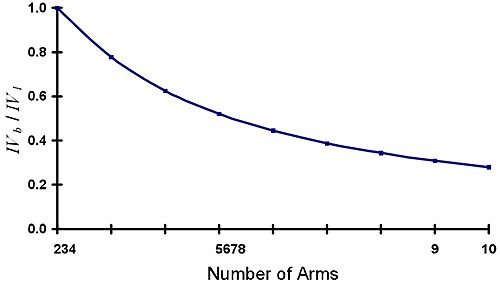Conventional size exclusion chromatography is a technique used to separate the macromolecules according to their hydrodynamic size. Following the separation a concentration detector measures the concentration of the sample eluting. To get quantitative results, the system needs to be calibrated using calibration standards. These standards are used to build a calibration curve relating the elution volume to the equivalent molecular weight of the standards. This technique is flawed if the standard and the unknown polymer occupy different volume for the same molecular weight.
Universal calibration takes into account that the volume of the unknown may be different than the calibration standard. It was shown by Benoit et al. that all polymers elute on the same curve when the calibration is made as a function of the volume occupied versus the elution volume. In short, universal calibration calibrates the columns as a direct function of the molecular size as opposed to the molecular weight for conventional calibration.
Molecular size is proportional to the product of the intrinsic viscosity and the molecular weight. With the use of the Viscotek differential bridge viscometer, intrinsic viscosity can be obtained at every elution slice. The universal calibration curve is then constructed by plotting the double logarithmic curve of the product of the intrinsic viscosity and the molecular weight versus the retention volume.
In this application communication the universal calibration method is used to differentiate between the linear and branched polystyrene. The viscometer is used to assess the branching number.
Three samples of star-branched polystyrene of different molecular weight were studied using the universal calibration method. Additionally linear polystyrene standards were used to construct the universal calibration curve.
For these measurements, the eluent was tetrahydrofuran (THF). The eluent was degassed and pumped it at a constant flow rate of 1.0 mL/min. The autosampler was used to inject 50 µL of the solution prepared at approximately 0.8 mg/mL . The separation was performed using two 30 cm mixed bed linear columns in series.
The detection was done using a Viscotek viscometer and a Viscotek differential refractometer (RI).

|
Linear polystyrene and star-branched polystyrene cannot be distinguished from elution volume alone. Figure 1 shows in green the universal calibration curve built using the linear polystyrene samples. The straight line formed by the calibration indicates that the columns are separating the samples in this size range in a linear fashion. Figure 1 also presents the RI signal for the linear polystyrene standard eluting at 11 mL and the star branched polystyrene eluting at the same volume. The curves are similar, it is impossible to tell without a-priori information if the sample is branched using the RI detector alone.
By coupling the chromatography system with a viscometer, both molecular weight and number of branches can be determined directly.
MW (g/mol) | IV star (dL/g) | IV linear (dL/g) | IV ratio | Bn |
|---|---|---|---|---|
340,000 | 0.805 | 1.162 | 0.693 | 4 |
100,000 | 0.315 | 0.497 | 0.639 | 5 |
2,500,000 | 1.308 | 4.632 | 0.282 | 10 |
Table 1 reveals that the ratio of intrinsic viscosity of linear to branched polystyrene is a direct function of the number of arms. The relationship between viscosity of the regularly distributed star-branched polystyrene to the linear polystyrene can be expressed as follows:
Where g is the ratio of the intrinsic viscosity of the branched polystyrene over the linear one. The number of arms is f.

|
Figure 2 shows the theoretical comparison of intrinsic viscosity ratio as a function of the number of arms.

|
It was shown in this application communication that the number of branches of a star polymer can be assessed by merely adding a viscometer detector to a conventional chromatography system. The viscometer is also used to construct the universal calibration curve that has been shown to measure accurately the molecular weight of linear and branched polymers as well as copolymers.
Grubisic, Z.; Rempp, R.; Benoit, H. J. Polym. Sci. Part B 1967, 5, 753